Pearson BTEC HND Unit 24: Understanding the Learning Process Report
VerifiedAdded on 2020/06/04
|22
|5797
|33
Report
AI Summary
This report delves into the multifaceted learning process within the health and social care sector. It begins by exploring various learning domains, including the cognitive, affective, and psychomotor domains, with a focus on Bloom's Taxonomy. The report then examines key learning theories such as behaviorism, cognitive information processing, and constructivism, highlighting their relevance to skill development. Furthermore, it analyzes how learning occurs in the workplace, referencing Kolb's learning cycle. The report also discusses learning styles, the factors that influence effective learning, and provides a self-assessment using the VARK system. Finally, it covers the concept of learning styles and strategies for delivering and assessing learning within the health and social care context.
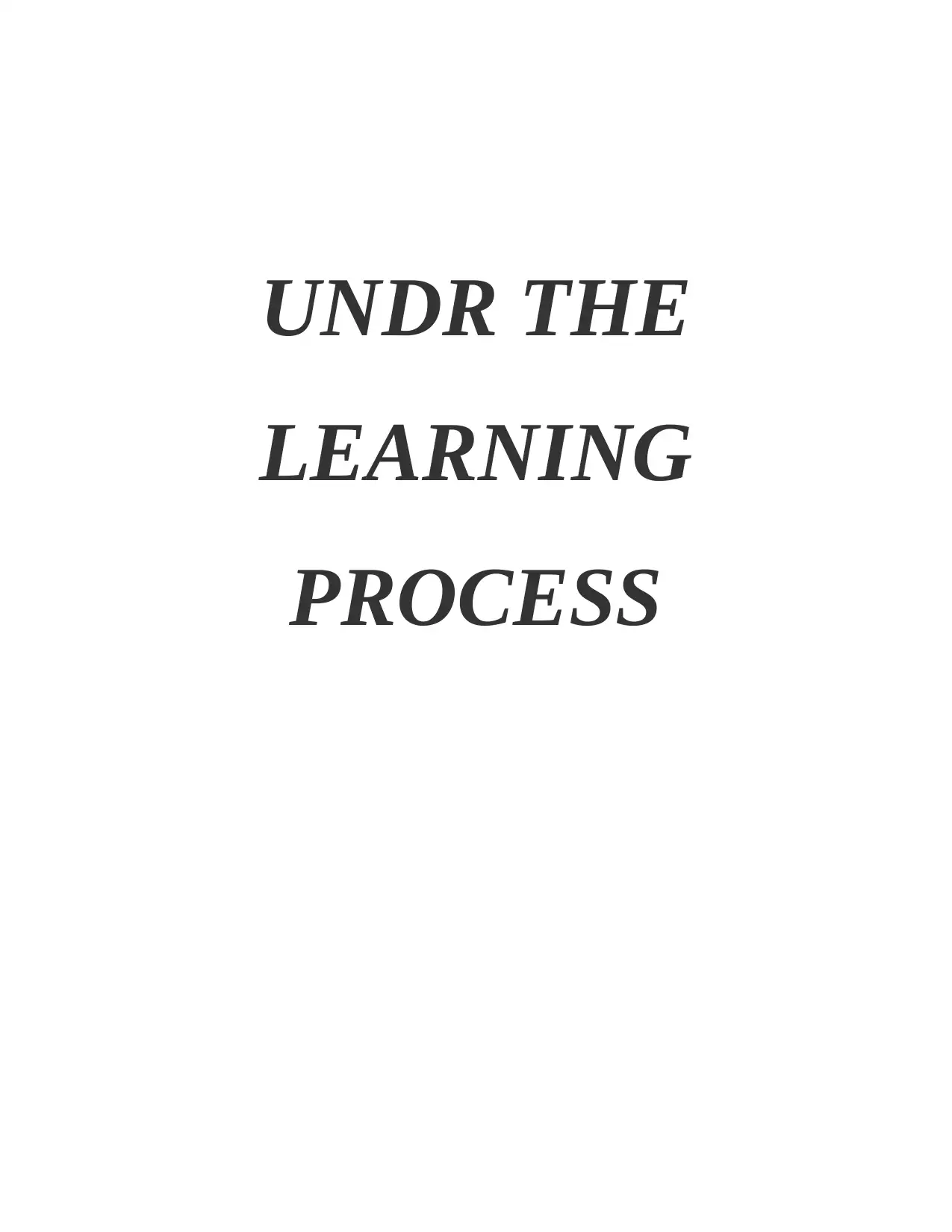
UNDR THE
LEARNING
PROCESS
LEARNING
PROCESS
Paraphrase This Document
Need a fresh take? Get an instant paraphrase of this document with our AI Paraphraser
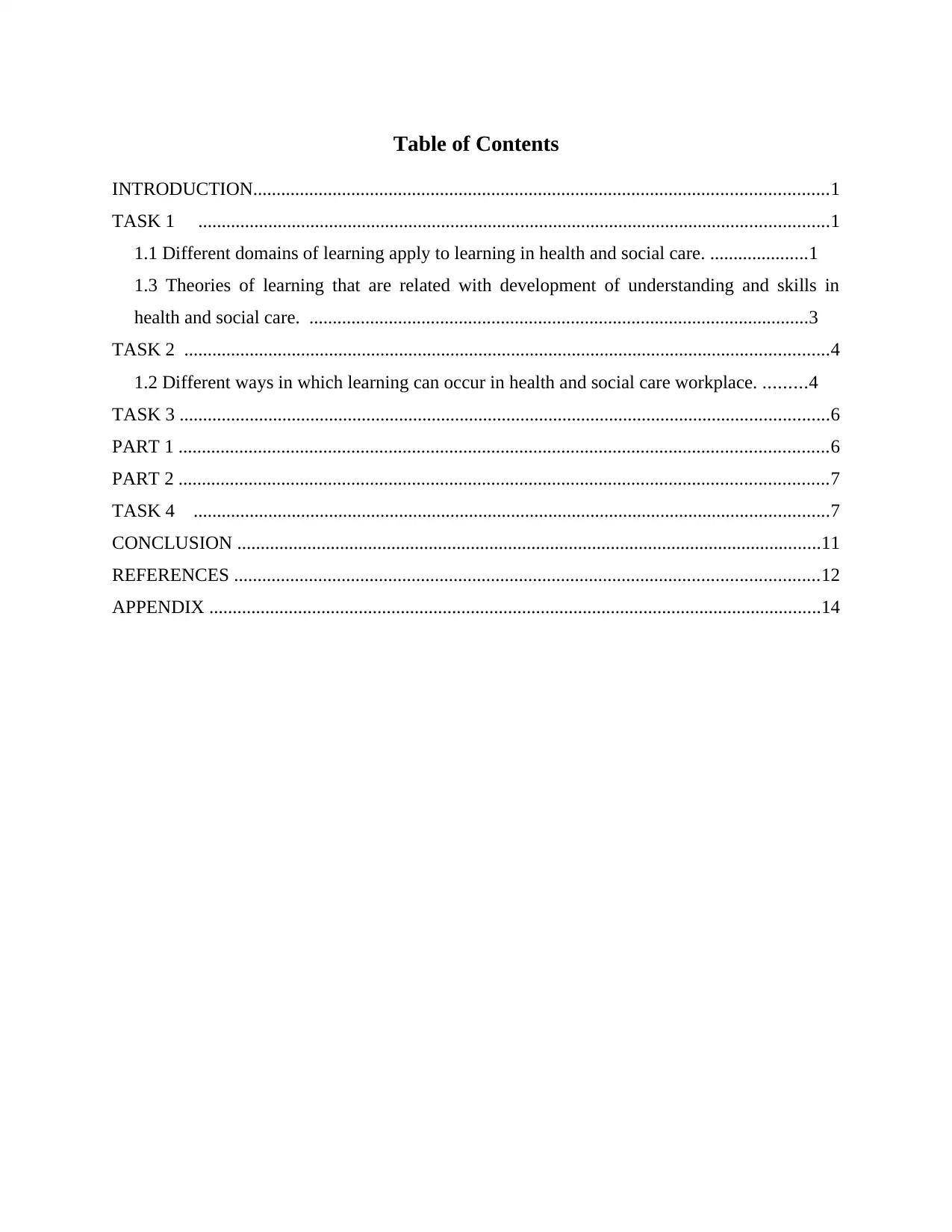
Table of Contents
INTRODUCTION...........................................................................................................................1
TASK 1 .......................................................................................................................................1
1.1 Different domains of learning apply to learning in health and social care. .....................1
1.3 Theories of learning that are related with development of understanding and skills in
health and social care. ...........................................................................................................3
TASK 2 ..........................................................................................................................................4
1.2 Different ways in which learning can occur in health and social care workplace. .........4
TASK 3 ...........................................................................................................................................6
PART 1 ...........................................................................................................................................6
PART 2 ...........................................................................................................................................7
TASK 4 ........................................................................................................................................7
CONCLUSION .............................................................................................................................11
REFERENCES .............................................................................................................................12
APPENDIX ...................................................................................................................................14
INTRODUCTION...........................................................................................................................1
TASK 1 .......................................................................................................................................1
1.1 Different domains of learning apply to learning in health and social care. .....................1
1.3 Theories of learning that are related with development of understanding and skills in
health and social care. ...........................................................................................................3
TASK 2 ..........................................................................................................................................4
1.2 Different ways in which learning can occur in health and social care workplace. .........4
TASK 3 ...........................................................................................................................................6
PART 1 ...........................................................................................................................................6
PART 2 ...........................................................................................................................................7
TASK 4 ........................................................................................................................................7
CONCLUSION .............................................................................................................................11
REFERENCES .............................................................................................................................12
APPENDIX ...................................................................................................................................14

⊘ This is a preview!⊘
Do you want full access?
Subscribe today to unlock all pages.

Trusted by 1+ million students worldwide
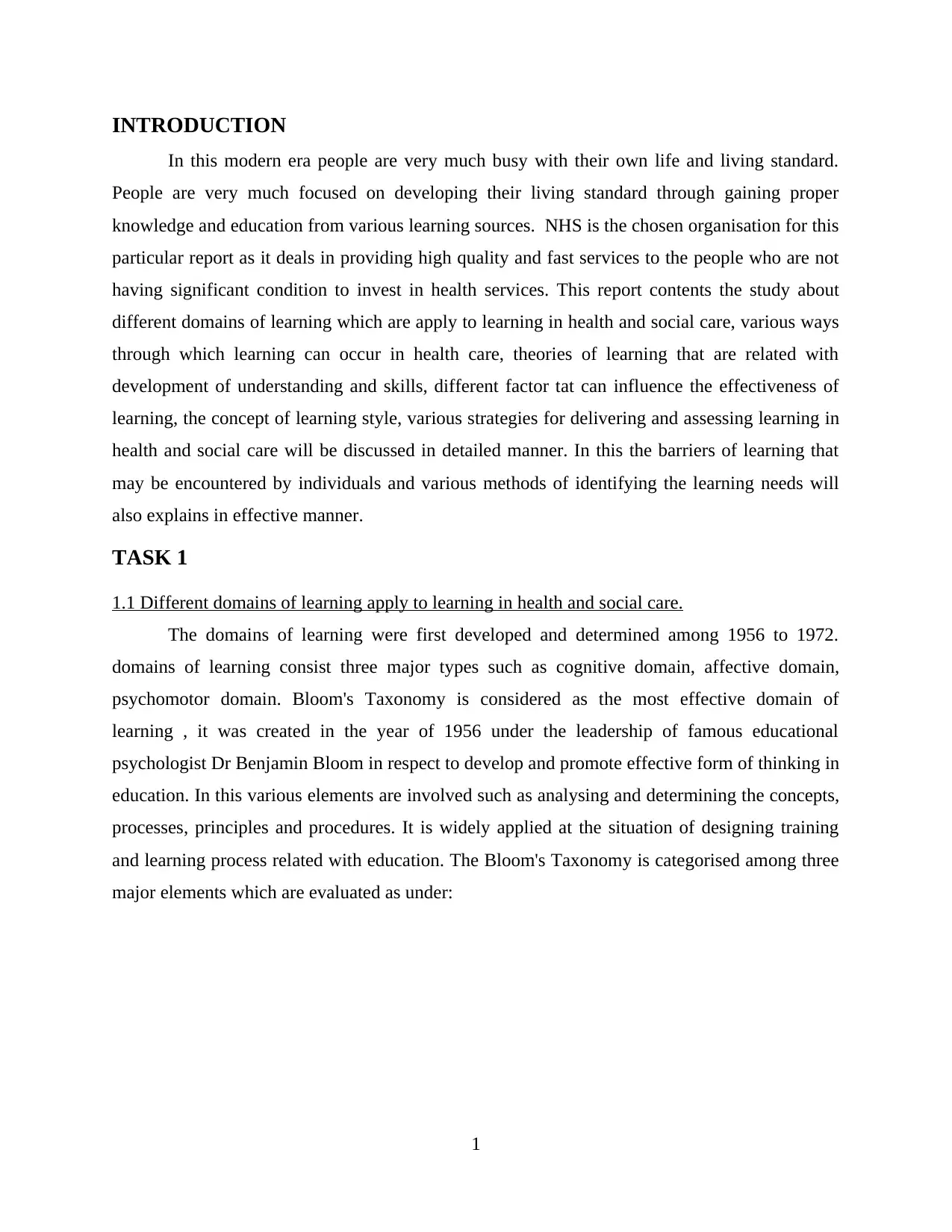
INTRODUCTION
In this modern era people are very much busy with their own life and living standard.
People are very much focused on developing their living standard through gaining proper
knowledge and education from various learning sources. NHS is the chosen organisation for this
particular report as it deals in providing high quality and fast services to the people who are not
having significant condition to invest in health services. This report contents the study about
different domains of learning which are apply to learning in health and social care, various ways
through which learning can occur in health care, theories of learning that are related with
development of understanding and skills, different factor tat can influence the effectiveness of
learning, the concept of learning style, various strategies for delivering and assessing learning in
health and social care will be discussed in detailed manner. In this the barriers of learning that
may be encountered by individuals and various methods of identifying the learning needs will
also explains in effective manner.
TASK 1
1.1 Different domains of learning apply to learning in health and social care.
The domains of learning were first developed and determined among 1956 to 1972.
domains of learning consist three major types such as cognitive domain, affective domain,
psychomotor domain. Bloom's Taxonomy is considered as the most effective domain of
learning , it was created in the year of 1956 under the leadership of famous educational
psychologist Dr Benjamin Bloom in respect to develop and promote effective form of thinking in
education. In this various elements are involved such as analysing and determining the concepts,
processes, principles and procedures. It is widely applied at the situation of designing training
and learning process related with education. The Bloom's Taxonomy is categorised among three
major elements which are evaluated as under:
1
In this modern era people are very much busy with their own life and living standard.
People are very much focused on developing their living standard through gaining proper
knowledge and education from various learning sources. NHS is the chosen organisation for this
particular report as it deals in providing high quality and fast services to the people who are not
having significant condition to invest in health services. This report contents the study about
different domains of learning which are apply to learning in health and social care, various ways
through which learning can occur in health care, theories of learning that are related with
development of understanding and skills, different factor tat can influence the effectiveness of
learning, the concept of learning style, various strategies for delivering and assessing learning in
health and social care will be discussed in detailed manner. In this the barriers of learning that
may be encountered by individuals and various methods of identifying the learning needs will
also explains in effective manner.
TASK 1
1.1 Different domains of learning apply to learning in health and social care.
The domains of learning were first developed and determined among 1956 to 1972.
domains of learning consist three major types such as cognitive domain, affective domain,
psychomotor domain. Bloom's Taxonomy is considered as the most effective domain of
learning , it was created in the year of 1956 under the leadership of famous educational
psychologist Dr Benjamin Bloom in respect to develop and promote effective form of thinking in
education. In this various elements are involved such as analysing and determining the concepts,
processes, principles and procedures. It is widely applied at the situation of designing training
and learning process related with education. The Bloom's Taxonomy is categorised among three
major elements which are evaluated as under:
1
Paraphrase This Document
Need a fresh take? Get an instant paraphrase of this document with our AI Paraphraser
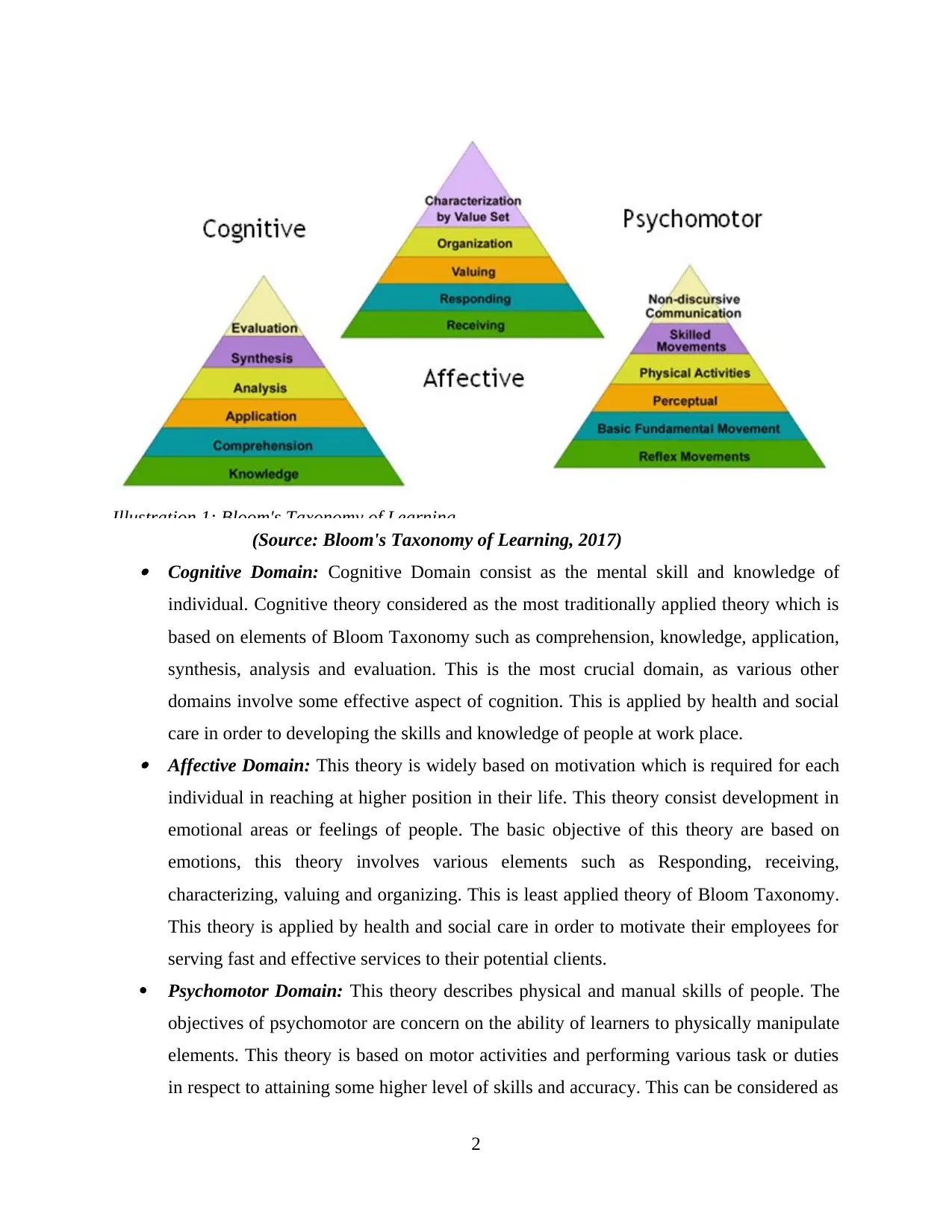
(Source: Bloom's Taxonomy of Learning, 2017) Cognitive Domain: Cognitive Domain consist as the mental skill and knowledge of
individual. Cognitive theory considered as the most traditionally applied theory which is
based on elements of Bloom Taxonomy such as comprehension, knowledge, application,
synthesis, analysis and evaluation. This is the most crucial domain, as various other
domains involve some effective aspect of cognition. This is applied by health and social
care in order to developing the skills and knowledge of people at work place. Affective Domain: This theory is widely based on motivation which is required for each
individual in reaching at higher position in their life. This theory consist development in
emotional areas or feelings of people. The basic objective of this theory are based on
emotions, this theory involves various elements such as Responding, receiving,
characterizing, valuing and organizing. This is least applied theory of Bloom Taxonomy.
This theory is applied by health and social care in order to motivate their employees for
serving fast and effective services to their potential clients.
Psychomotor Domain: This theory describes physical and manual skills of people. The
objectives of psychomotor are concern on the ability of learners to physically manipulate
elements. This theory is based on motor activities and performing various task or duties
in respect to attaining some higher level of skills and accuracy. This can be considered as
2
Illustration 1: Bloom's Taxonomy of Learning
individual. Cognitive theory considered as the most traditionally applied theory which is
based on elements of Bloom Taxonomy such as comprehension, knowledge, application,
synthesis, analysis and evaluation. This is the most crucial domain, as various other
domains involve some effective aspect of cognition. This is applied by health and social
care in order to developing the skills and knowledge of people at work place. Affective Domain: This theory is widely based on motivation which is required for each
individual in reaching at higher position in their life. This theory consist development in
emotional areas or feelings of people. The basic objective of this theory are based on
emotions, this theory involves various elements such as Responding, receiving,
characterizing, valuing and organizing. This is least applied theory of Bloom Taxonomy.
This theory is applied by health and social care in order to motivate their employees for
serving fast and effective services to their potential clients.
Psychomotor Domain: This theory describes physical and manual skills of people. The
objectives of psychomotor are concern on the ability of learners to physically manipulate
elements. This theory is based on motor activities and performing various task or duties
in respect to attaining some higher level of skills and accuracy. This can be considered as
2
Illustration 1: Bloom's Taxonomy of Learning
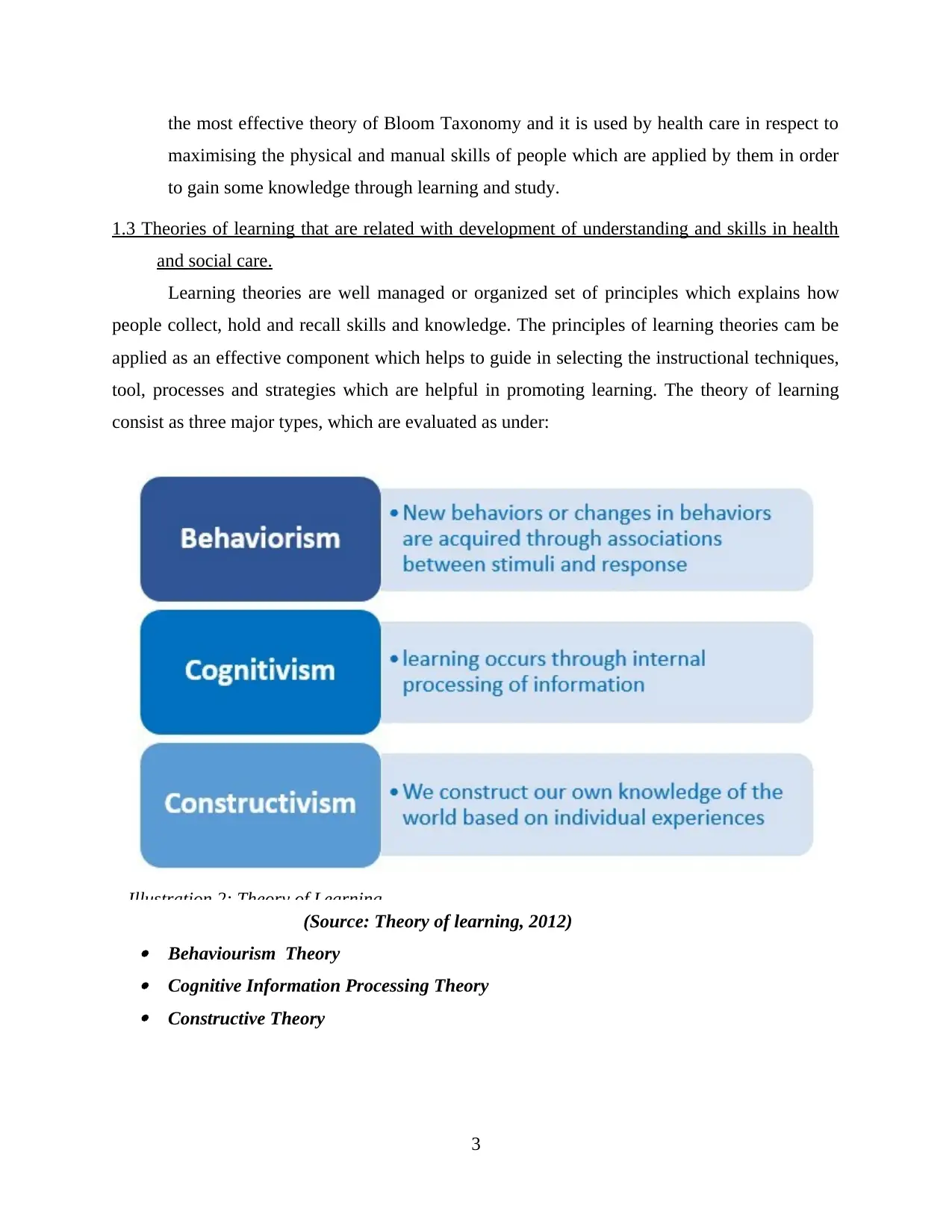
the most effective theory of Bloom Taxonomy and it is used by health care in respect to
maximising the physical and manual skills of people which are applied by them in order
to gain some knowledge through learning and study.
1.3 Theories of learning that are related with development of understanding and skills in health
and social care.
Learning theories are well managed or organized set of principles which explains how
people collect, hold and recall skills and knowledge. The principles of learning theories cam be
applied as an effective component which helps to guide in selecting the instructional techniques,
tool, processes and strategies which are helpful in promoting learning. The theory of learning
consist as three major types, which are evaluated as under:
(Source: Theory of learning, 2012) Behaviourism Theory Cognitive Information Processing Theory Constructive Theory
3
Illustration 2: Theory of Learning
maximising the physical and manual skills of people which are applied by them in order
to gain some knowledge through learning and study.
1.3 Theories of learning that are related with development of understanding and skills in health
and social care.
Learning theories are well managed or organized set of principles which explains how
people collect, hold and recall skills and knowledge. The principles of learning theories cam be
applied as an effective component which helps to guide in selecting the instructional techniques,
tool, processes and strategies which are helpful in promoting learning. The theory of learning
consist as three major types, which are evaluated as under:
(Source: Theory of learning, 2012) Behaviourism Theory Cognitive Information Processing Theory Constructive Theory
3
Illustration 2: Theory of Learning
⊘ This is a preview!⊘
Do you want full access?
Subscribe today to unlock all pages.

Trusted by 1+ million students worldwide
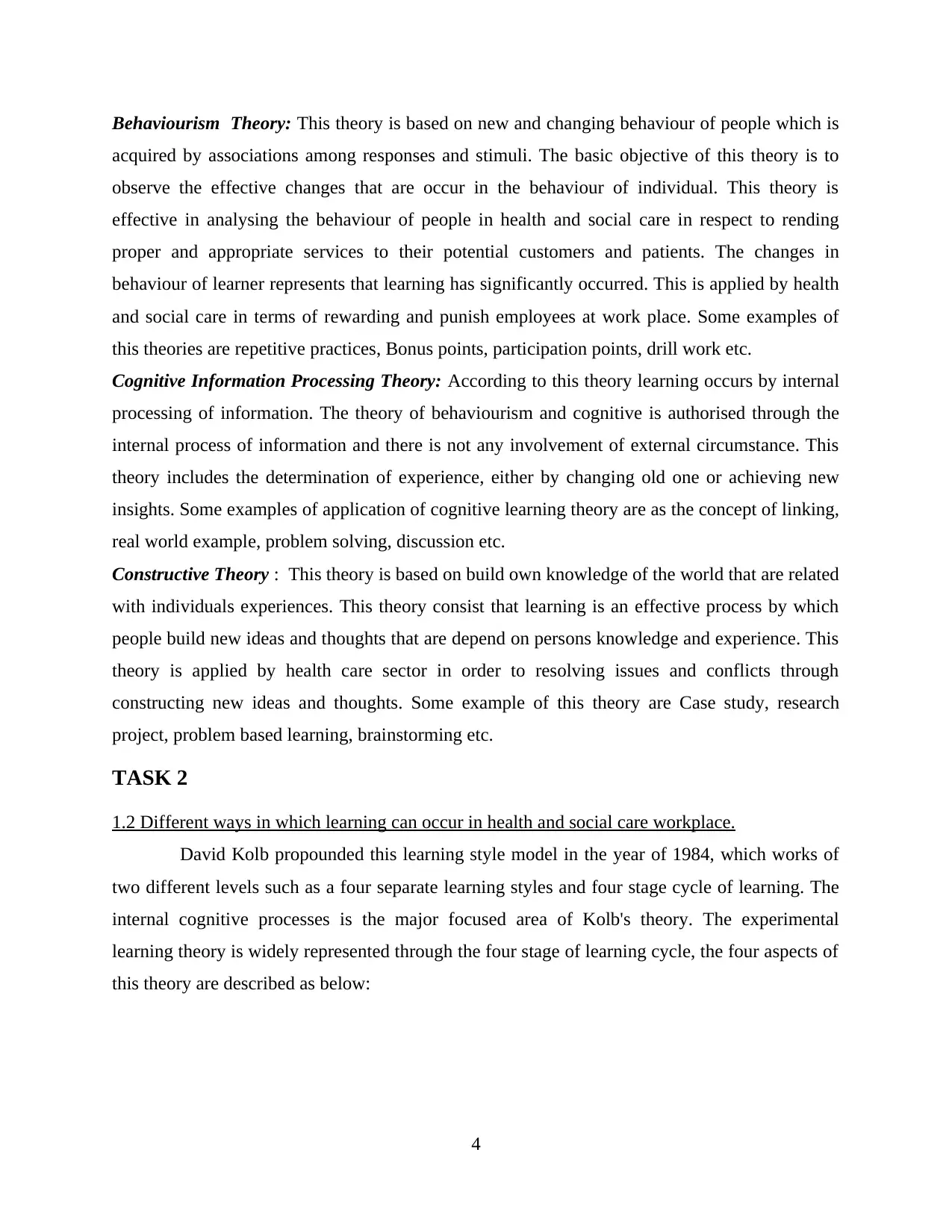
Behaviourism Theory: This theory is based on new and changing behaviour of people which is
acquired by associations among responses and stimuli. The basic objective of this theory is to
observe the effective changes that are occur in the behaviour of individual. This theory is
effective in analysing the behaviour of people in health and social care in respect to rending
proper and appropriate services to their potential customers and patients. The changes in
behaviour of learner represents that learning has significantly occurred. This is applied by health
and social care in terms of rewarding and punish employees at work place. Some examples of
this theories are repetitive practices, Bonus points, participation points, drill work etc.
Cognitive Information Processing Theory: According to this theory learning occurs by internal
processing of information. The theory of behaviourism and cognitive is authorised through the
internal process of information and there is not any involvement of external circumstance. This
theory includes the determination of experience, either by changing old one or achieving new
insights. Some examples of application of cognitive learning theory are as the concept of linking,
real world example, problem solving, discussion etc.
Constructive Theory : This theory is based on build own knowledge of the world that are related
with individuals experiences. This theory consist that learning is an effective process by which
people build new ideas and thoughts that are depend on persons knowledge and experience. This
theory is applied by health care sector in order to resolving issues and conflicts through
constructing new ideas and thoughts. Some example of this theory are Case study, research
project, problem based learning, brainstorming etc.
TASK 2
1.2 Different ways in which learning can occur in health and social care workplace.
David Kolb propounded this learning style model in the year of 1984, which works of
two different levels such as a four separate learning styles and four stage cycle of learning. The
internal cognitive processes is the major focused area of Kolb's theory. The experimental
learning theory is widely represented through the four stage of learning cycle, the four aspects of
this theory are described as below:
4
acquired by associations among responses and stimuli. The basic objective of this theory is to
observe the effective changes that are occur in the behaviour of individual. This theory is
effective in analysing the behaviour of people in health and social care in respect to rending
proper and appropriate services to their potential customers and patients. The changes in
behaviour of learner represents that learning has significantly occurred. This is applied by health
and social care in terms of rewarding and punish employees at work place. Some examples of
this theories are repetitive practices, Bonus points, participation points, drill work etc.
Cognitive Information Processing Theory: According to this theory learning occurs by internal
processing of information. The theory of behaviourism and cognitive is authorised through the
internal process of information and there is not any involvement of external circumstance. This
theory includes the determination of experience, either by changing old one or achieving new
insights. Some examples of application of cognitive learning theory are as the concept of linking,
real world example, problem solving, discussion etc.
Constructive Theory : This theory is based on build own knowledge of the world that are related
with individuals experiences. This theory consist that learning is an effective process by which
people build new ideas and thoughts that are depend on persons knowledge and experience. This
theory is applied by health care sector in order to resolving issues and conflicts through
constructing new ideas and thoughts. Some example of this theory are Case study, research
project, problem based learning, brainstorming etc.
TASK 2
1.2 Different ways in which learning can occur in health and social care workplace.
David Kolb propounded this learning style model in the year of 1984, which works of
two different levels such as a four separate learning styles and four stage cycle of learning. The
internal cognitive processes is the major focused area of Kolb's theory. The experimental
learning theory is widely represented through the four stage of learning cycle, the four aspects of
this theory are described as below:
4
Paraphrase This Document
Need a fresh take? Get an instant paraphrase of this document with our AI Paraphraser
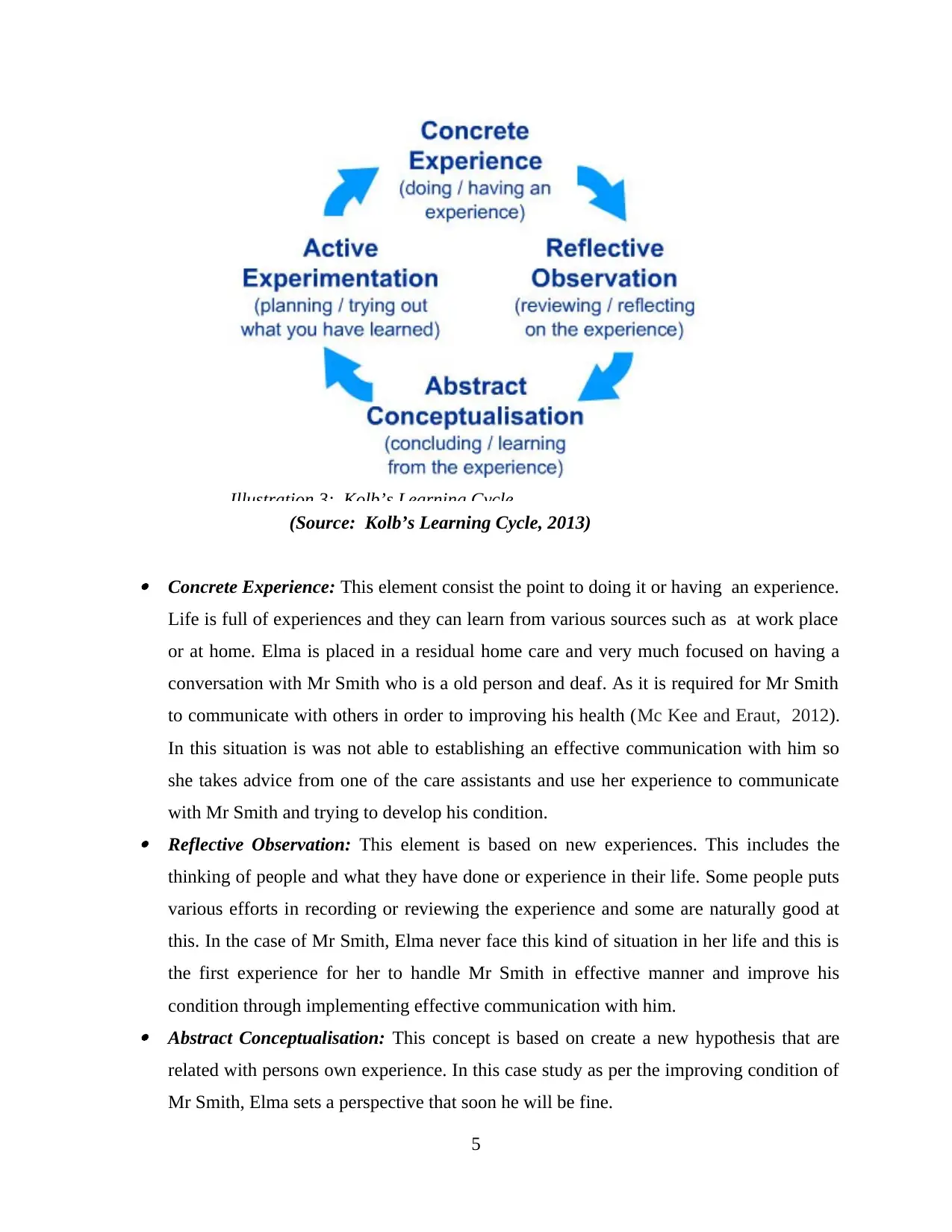
(Source: Kolb’s Learning Cycle, 2013)
Concrete Experience: This element consist the point to doing it or having an experience.
Life is full of experiences and they can learn from various sources such as at work place
or at home. Elma is placed in a residual home care and very much focused on having a
conversation with Mr Smith who is a old person and deaf. As it is required for Mr Smith
to communicate with others in order to improving his health (Mc Kee and Eraut, 2012).
In this situation is was not able to establishing an effective communication with him so
she takes advice from one of the care assistants and use her experience to communicate
with Mr Smith and trying to develop his condition. Reflective Observation: This element is based on new experiences. This includes the
thinking of people and what they have done or experience in their life. Some people puts
various efforts in recording or reviewing the experience and some are naturally good at
this. In the case of Mr Smith, Elma never face this kind of situation in her life and this is
the first experience for her to handle Mr Smith in effective manner and improve his
condition through implementing effective communication with him. Abstract Conceptualisation: This concept is based on create a new hypothesis that are
related with persons own experience. In this case study as per the improving condition of
Mr Smith, Elma sets a perspective that soon he will be fine.
5
Illustration 3: Kolb’s Learning Cycle
Concrete Experience: This element consist the point to doing it or having an experience.
Life is full of experiences and they can learn from various sources such as at work place
or at home. Elma is placed in a residual home care and very much focused on having a
conversation with Mr Smith who is a old person and deaf. As it is required for Mr Smith
to communicate with others in order to improving his health (Mc Kee and Eraut, 2012).
In this situation is was not able to establishing an effective communication with him so
she takes advice from one of the care assistants and use her experience to communicate
with Mr Smith and trying to develop his condition. Reflective Observation: This element is based on new experiences. This includes the
thinking of people and what they have done or experience in their life. Some people puts
various efforts in recording or reviewing the experience and some are naturally good at
this. In the case of Mr Smith, Elma never face this kind of situation in her life and this is
the first experience for her to handle Mr Smith in effective manner and improve his
condition through implementing effective communication with him. Abstract Conceptualisation: This concept is based on create a new hypothesis that are
related with persons own experience. In this case study as per the improving condition of
Mr Smith, Elma sets a perspective that soon he will be fine.
5
Illustration 3: Kolb’s Learning Cycle
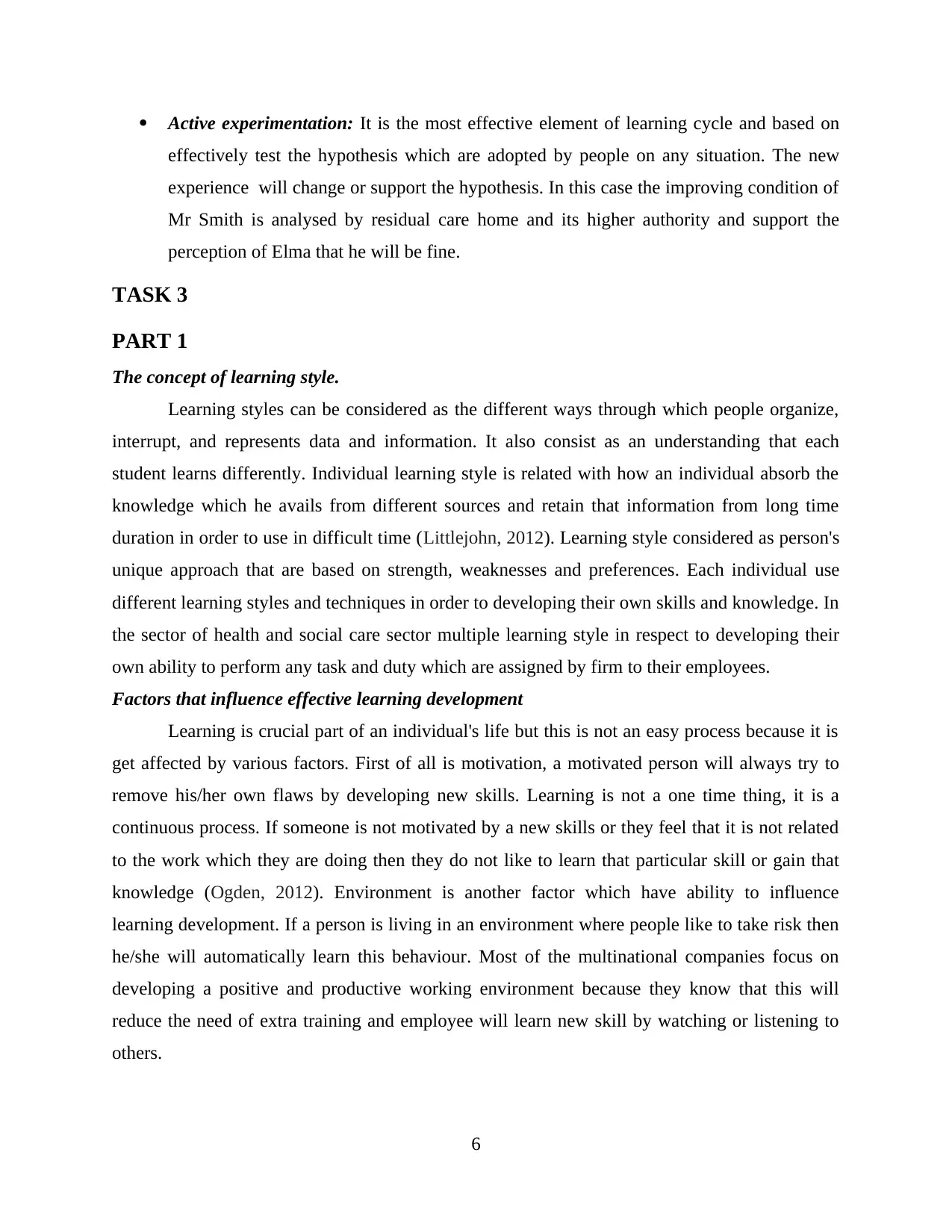
Active experimentation: It is the most effective element of learning cycle and based on
effectively test the hypothesis which are adopted by people on any situation. The new
experience will change or support the hypothesis. In this case the improving condition of
Mr Smith is analysed by residual care home and its higher authority and support the
perception of Elma that he will be fine.
TASK 3
PART 1
The concept of learning style.
Learning styles can be considered as the different ways through which people organize,
interrupt, and represents data and information. It also consist as an understanding that each
student learns differently. Individual learning style is related with how an individual absorb the
knowledge which he avails from different sources and retain that information from long time
duration in order to use in difficult time (Littlejohn, 2012). Learning style considered as person's
unique approach that are based on strength, weaknesses and preferences. Each individual use
different learning styles and techniques in order to developing their own skills and knowledge. In
the sector of health and social care sector multiple learning style in respect to developing their
own ability to perform any task and duty which are assigned by firm to their employees.
Factors that influence effective learning development
Learning is crucial part of an individual's life but this is not an easy process because it is
get affected by various factors. First of all is motivation, a motivated person will always try to
remove his/her own flaws by developing new skills. Learning is not a one time thing, it is a
continuous process. If someone is not motivated by a new skills or they feel that it is not related
to the work which they are doing then they do not like to learn that particular skill or gain that
knowledge (Ogden, 2012). Environment is another factor which have ability to influence
learning development. If a person is living in an environment where people like to take risk then
he/she will automatically learn this behaviour. Most of the multinational companies focus on
developing a positive and productive working environment because they know that this will
reduce the need of extra training and employee will learn new skill by watching or listening to
others.
6
effectively test the hypothesis which are adopted by people on any situation. The new
experience will change or support the hypothesis. In this case the improving condition of
Mr Smith is analysed by residual care home and its higher authority and support the
perception of Elma that he will be fine.
TASK 3
PART 1
The concept of learning style.
Learning styles can be considered as the different ways through which people organize,
interrupt, and represents data and information. It also consist as an understanding that each
student learns differently. Individual learning style is related with how an individual absorb the
knowledge which he avails from different sources and retain that information from long time
duration in order to use in difficult time (Littlejohn, 2012). Learning style considered as person's
unique approach that are based on strength, weaknesses and preferences. Each individual use
different learning styles and techniques in order to developing their own skills and knowledge. In
the sector of health and social care sector multiple learning style in respect to developing their
own ability to perform any task and duty which are assigned by firm to their employees.
Factors that influence effective learning development
Learning is crucial part of an individual's life but this is not an easy process because it is
get affected by various factors. First of all is motivation, a motivated person will always try to
remove his/her own flaws by developing new skills. Learning is not a one time thing, it is a
continuous process. If someone is not motivated by a new skills or they feel that it is not related
to the work which they are doing then they do not like to learn that particular skill or gain that
knowledge (Ogden, 2012). Environment is another factor which have ability to influence
learning development. If a person is living in an environment where people like to take risk then
he/she will automatically learn this behaviour. Most of the multinational companies focus on
developing a positive and productive working environment because they know that this will
reduce the need of extra training and employee will learn new skill by watching or listening to
others.
6
⊘ This is a preview!⊘
Do you want full access?
Subscribe today to unlock all pages.

Trusted by 1+ million students worldwide
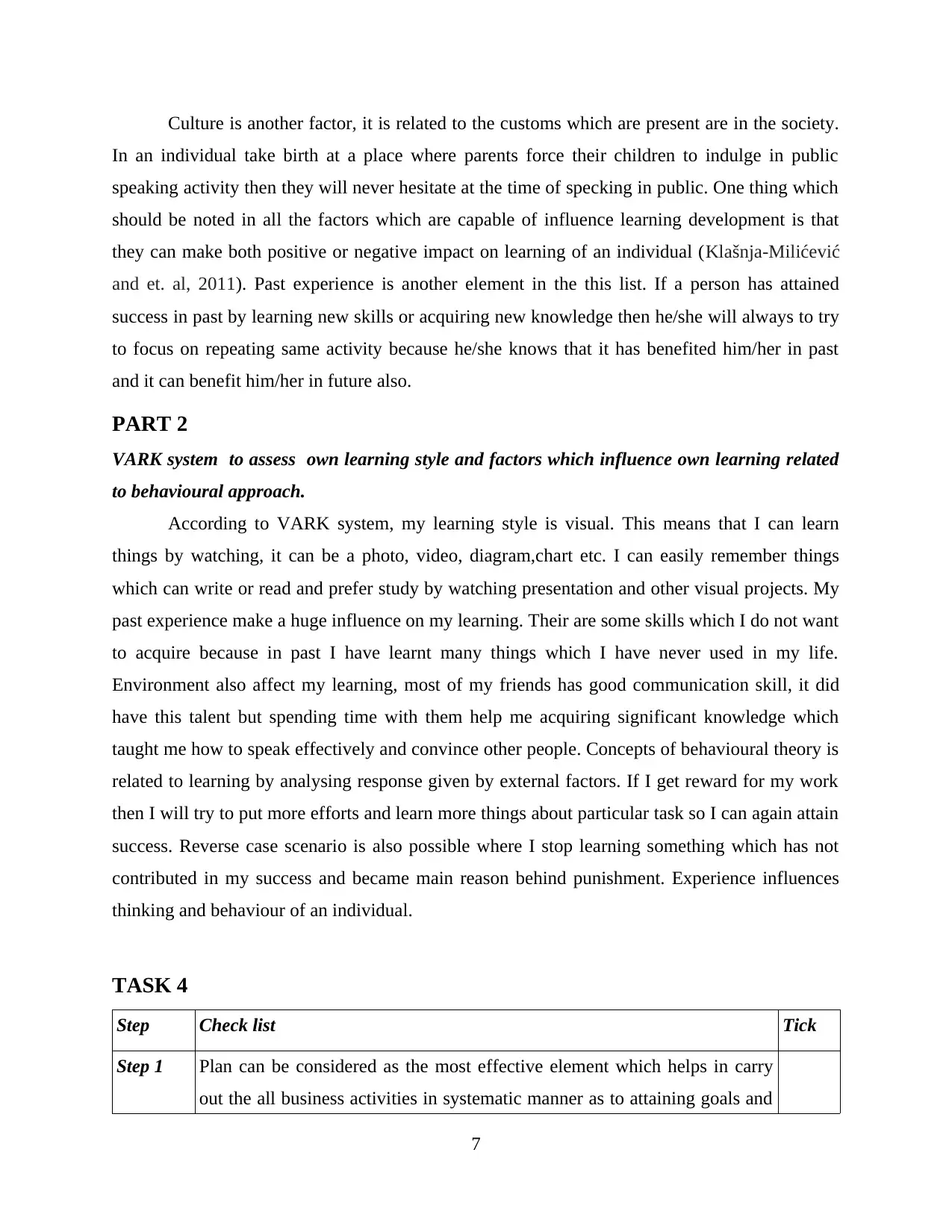
Culture is another factor, it is related to the customs which are present are in the society.
In an individual take birth at a place where parents force their children to indulge in public
speaking activity then they will never hesitate at the time of specking in public. One thing which
should be noted in all the factors which are capable of influence learning development is that
they can make both positive or negative impact on learning of an individual (Klašnja-Milićević
and et. al, 2011). Past experience is another element in the this list. If a person has attained
success in past by learning new skills or acquiring new knowledge then he/she will always to try
to focus on repeating same activity because he/she knows that it has benefited him/her in past
and it can benefit him/her in future also.
PART 2
VARK system to assess own learning style and factors which influence own learning related
to behavioural approach.
According to VARK system, my learning style is visual. This means that I can learn
things by watching, it can be a photo, video, diagram,chart etc. I can easily remember things
which can write or read and prefer study by watching presentation and other visual projects. My
past experience make a huge influence on my learning. Their are some skills which I do not want
to acquire because in past I have learnt many things which I have never used in my life.
Environment also affect my learning, most of my friends has good communication skill, it did
have this talent but spending time with them help me acquiring significant knowledge which
taught me how to speak effectively and convince other people. Concepts of behavioural theory is
related to learning by analysing response given by external factors. If I get reward for my work
then I will try to put more efforts and learn more things about particular task so I can again attain
success. Reverse case scenario is also possible where I stop learning something which has not
contributed in my success and became main reason behind punishment. Experience influences
thinking and behaviour of an individual.
TASK 4
Step Check list Tick
Step 1 Plan can be considered as the most effective element which helps in carry
out the all business activities in systematic manner as to attaining goals and
7
In an individual take birth at a place where parents force their children to indulge in public
speaking activity then they will never hesitate at the time of specking in public. One thing which
should be noted in all the factors which are capable of influence learning development is that
they can make both positive or negative impact on learning of an individual (Klašnja-Milićević
and et. al, 2011). Past experience is another element in the this list. If a person has attained
success in past by learning new skills or acquiring new knowledge then he/she will always to try
to focus on repeating same activity because he/she knows that it has benefited him/her in past
and it can benefit him/her in future also.
PART 2
VARK system to assess own learning style and factors which influence own learning related
to behavioural approach.
According to VARK system, my learning style is visual. This means that I can learn
things by watching, it can be a photo, video, diagram,chart etc. I can easily remember things
which can write or read and prefer study by watching presentation and other visual projects. My
past experience make a huge influence on my learning. Their are some skills which I do not want
to acquire because in past I have learnt many things which I have never used in my life.
Environment also affect my learning, most of my friends has good communication skill, it did
have this talent but spending time with them help me acquiring significant knowledge which
taught me how to speak effectively and convince other people. Concepts of behavioural theory is
related to learning by analysing response given by external factors. If I get reward for my work
then I will try to put more efforts and learn more things about particular task so I can again attain
success. Reverse case scenario is also possible where I stop learning something which has not
contributed in my success and became main reason behind punishment. Experience influences
thinking and behaviour of an individual.
TASK 4
Step Check list Tick
Step 1 Plan can be considered as the most effective element which helps in carry
out the all business activities in systematic manner as to attaining goals and
7
Paraphrase This Document
Need a fresh take? Get an instant paraphrase of this document with our AI Paraphraser
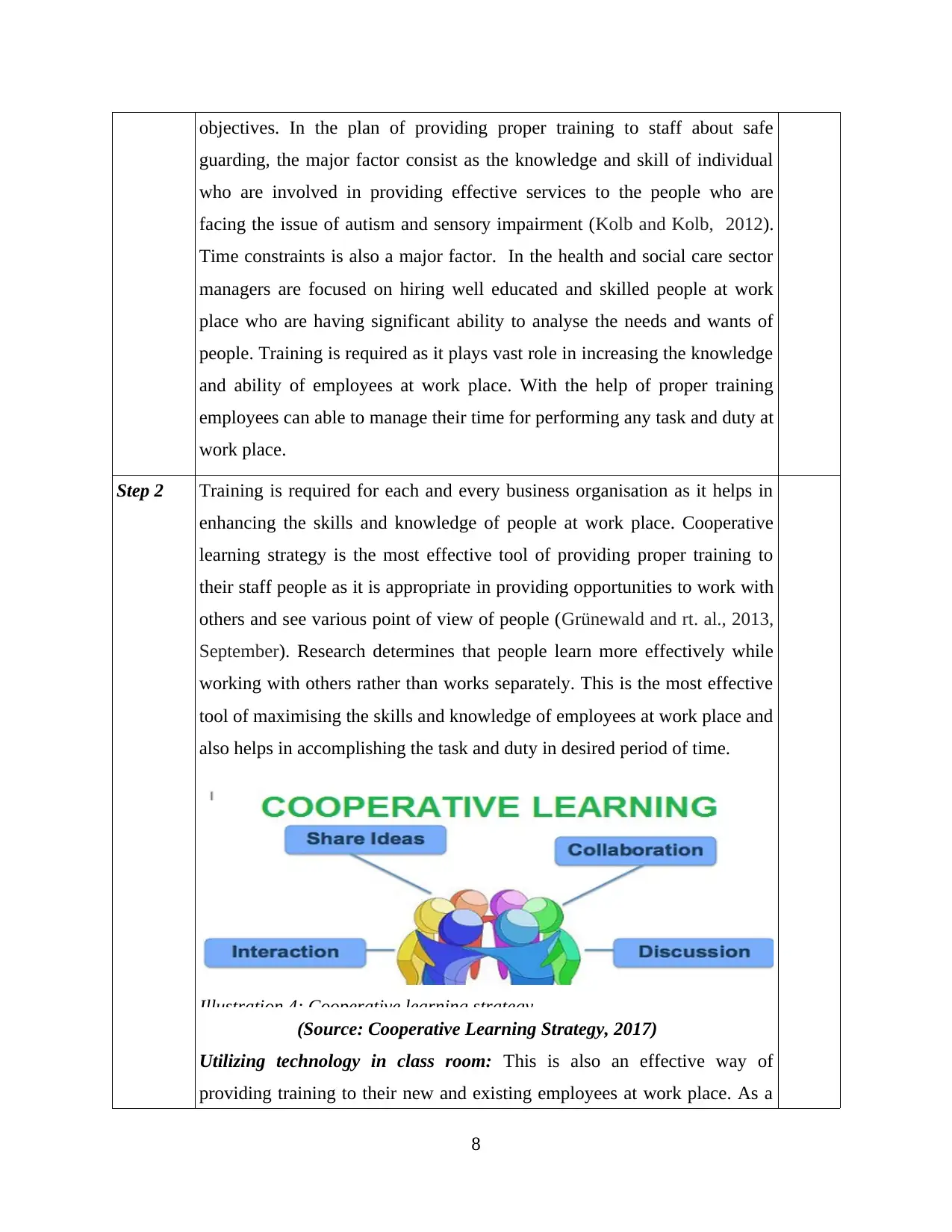
objectives. In the plan of providing proper training to staff about safe
guarding, the major factor consist as the knowledge and skill of individual
who are involved in providing effective services to the people who are
facing the issue of autism and sensory impairment (Kolb and Kolb, 2012).
Time constraints is also a major factor. In the health and social care sector
managers are focused on hiring well educated and skilled people at work
place who are having significant ability to analyse the needs and wants of
people. Training is required as it plays vast role in increasing the knowledge
and ability of employees at work place. With the help of proper training
employees can able to manage their time for performing any task and duty at
work place.
Step 2 Training is required for each and every business organisation as it helps in
enhancing the skills and knowledge of people at work place. Cooperative
learning strategy is the most effective tool of providing proper training to
their staff people as it is appropriate in providing opportunities to work with
others and see various point of view of people (Grünewald and rt. al., 2013,
September). Research determines that people learn more effectively while
working with others rather than works separately. This is the most effective
tool of maximising the skills and knowledge of employees at work place and
also helps in accomplishing the task and duty in desired period of time.
(Source: Cooperative Learning Strategy, 2017)
Utilizing technology in class room: This is also an effective way of
providing training to their new and existing employees at work place. As a
8
Illustration 4: Cooperative learning strategy
guarding, the major factor consist as the knowledge and skill of individual
who are involved in providing effective services to the people who are
facing the issue of autism and sensory impairment (Kolb and Kolb, 2012).
Time constraints is also a major factor. In the health and social care sector
managers are focused on hiring well educated and skilled people at work
place who are having significant ability to analyse the needs and wants of
people. Training is required as it plays vast role in increasing the knowledge
and ability of employees at work place. With the help of proper training
employees can able to manage their time for performing any task and duty at
work place.
Step 2 Training is required for each and every business organisation as it helps in
enhancing the skills and knowledge of people at work place. Cooperative
learning strategy is the most effective tool of providing proper training to
their staff people as it is appropriate in providing opportunities to work with
others and see various point of view of people (Grünewald and rt. al., 2013,
September). Research determines that people learn more effectively while
working with others rather than works separately. This is the most effective
tool of maximising the skills and knowledge of employees at work place and
also helps in accomplishing the task and duty in desired period of time.
(Source: Cooperative Learning Strategy, 2017)
Utilizing technology in class room: This is also an effective way of
providing training to their new and existing employees at work place. As a
8
Illustration 4: Cooperative learning strategy
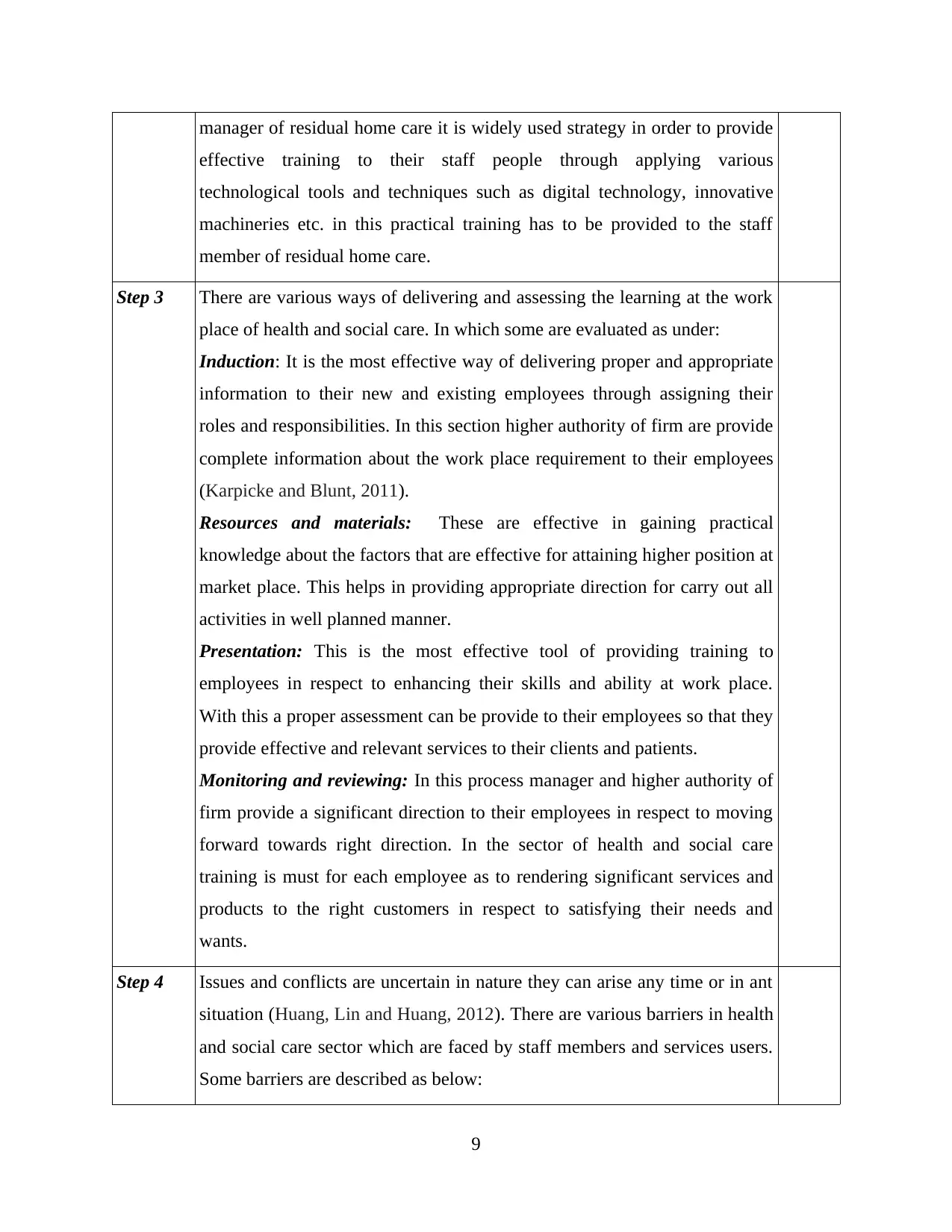
manager of residual home care it is widely used strategy in order to provide
effective training to their staff people through applying various
technological tools and techniques such as digital technology, innovative
machineries etc. in this practical training has to be provided to the staff
member of residual home care.
Step 3 There are various ways of delivering and assessing the learning at the work
place of health and social care. In which some are evaluated as under:
Induction: It is the most effective way of delivering proper and appropriate
information to their new and existing employees through assigning their
roles and responsibilities. In this section higher authority of firm are provide
complete information about the work place requirement to their employees
(Karpicke and Blunt, 2011).
Resources and materials: These are effective in gaining practical
knowledge about the factors that are effective for attaining higher position at
market place. This helps in providing appropriate direction for carry out all
activities in well planned manner.
Presentation: This is the most effective tool of providing training to
employees in respect to enhancing their skills and ability at work place.
With this a proper assessment can be provide to their employees so that they
provide effective and relevant services to their clients and patients.
Monitoring and reviewing: In this process manager and higher authority of
firm provide a significant direction to their employees in respect to moving
forward towards right direction. In the sector of health and social care
training is must for each employee as to rendering significant services and
products to the right customers in respect to satisfying their needs and
wants.
Step 4 Issues and conflicts are uncertain in nature they can arise any time or in ant
situation (Huang, Lin and Huang, 2012). There are various barriers in health
and social care sector which are faced by staff members and services users.
Some barriers are described as below:
9
effective training to their staff people through applying various
technological tools and techniques such as digital technology, innovative
machineries etc. in this practical training has to be provided to the staff
member of residual home care.
Step 3 There are various ways of delivering and assessing the learning at the work
place of health and social care. In which some are evaluated as under:
Induction: It is the most effective way of delivering proper and appropriate
information to their new and existing employees through assigning their
roles and responsibilities. In this section higher authority of firm are provide
complete information about the work place requirement to their employees
(Karpicke and Blunt, 2011).
Resources and materials: These are effective in gaining practical
knowledge about the factors that are effective for attaining higher position at
market place. This helps in providing appropriate direction for carry out all
activities in well planned manner.
Presentation: This is the most effective tool of providing training to
employees in respect to enhancing their skills and ability at work place.
With this a proper assessment can be provide to their employees so that they
provide effective and relevant services to their clients and patients.
Monitoring and reviewing: In this process manager and higher authority of
firm provide a significant direction to their employees in respect to moving
forward towards right direction. In the sector of health and social care
training is must for each employee as to rendering significant services and
products to the right customers in respect to satisfying their needs and
wants.
Step 4 Issues and conflicts are uncertain in nature they can arise any time or in ant
situation (Huang, Lin and Huang, 2012). There are various barriers in health
and social care sector which are faced by staff members and services users.
Some barriers are described as below:
9
⊘ This is a preview!⊘
Do you want full access?
Subscribe today to unlock all pages.

Trusted by 1+ million students worldwide
1 out of 22
Related Documents
Your All-in-One AI-Powered Toolkit for Academic Success.
+13062052269
info@desklib.com
Available 24*7 on WhatsApp / Email
![[object Object]](/_next/static/media/star-bottom.7253800d.svg)
Unlock your academic potential
Copyright © 2020–2025 A2Z Services. All Rights Reserved. Developed and managed by ZUCOL.



